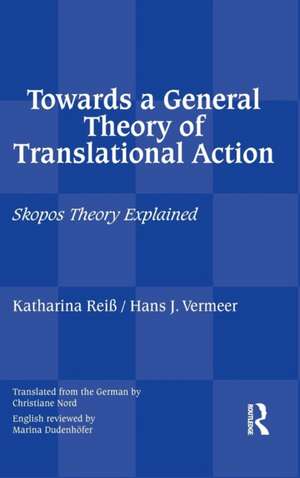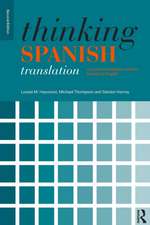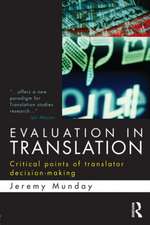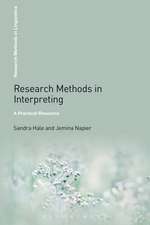Towards a General Theory of Translational Action: Skopos Theory Explained
Autor Katharina Reiss Traducere de Christiane Nord Autor Hans J Vermeeren Limba Engleză Hardback – 2 noi 2015
In her translation, Christiane Nord attempts to put skopos theory and her own concept of ‘function plus loyalty’ to the test, by producing a comprehensible, acceptable text for a rather heterogeneous audience of English-speaking students and scholars all over the world, at the same time as acting as a loyal intermediary for the authors, to whom she feels deeply indebted as a former student and colleague.
| Toate formatele și edițiile | Preț | Express |
|---|---|---|
| Paperback (1) | 444.19 lei 6-8 săpt. | |
| Taylor & Francis – 3 mar 2013 | 444.19 lei 6-8 săpt. | |
| Hardback (1) | 1218.08 lei 6-8 săpt. | |
| Taylor & Francis – 2 noi 2015 | 1218.08 lei 6-8 săpt. |
Preț: 1218.08 lei
Preț vechi: 1485.47 lei
-18% Nou
Puncte Express: 1827
Preț estimativ în valută:
233.09€ • 240.83$ • 193.90£
233.09€ • 240.83$ • 193.90£
Carte tipărită la comandă
Livrare economică 19 martie-02 aprilie
Preluare comenzi: 021 569.72.76
Specificații
ISBN-13: 9781138133365
ISBN-10: 1138133361
Pagini: 240
Dimensiuni: 156 x 234 x 14 mm
Greutate: 0.45 kg
Ediția:1
Editura: Taylor & Francis
Colecția Routledge
Locul publicării:Oxford, United Kingdom
ISBN-10: 1138133361
Pagini: 240
Dimensiuni: 156 x 234 x 14 mm
Greutate: 0.45 kg
Ediția:1
Editura: Taylor & Francis
Colecția Routledge
Locul publicării:Oxford, United Kingdom
Public țintă
PostgraduateCuprins
0. Introduction
0.1 Preliminary remarks
0.2 General epistemological considerations
0.3 The purpose of T&I studies
0.4 General remarks on terminology
Part I. Theoretical groundwork
1. Terminological distinctions
1.1 The need for a generic term
1.2 The advantage of neologisms
1.3 Formal distinctions
1.4 Summary 1
1.5 Other definitions
2. Of worlds and languages
2.1 Framework for a theory of translational action: an overview
2.2 The concept of ‘language’
2.3 Forms of transfer
2.4 Summary: ‘Transfer’ as a generic concept
2.5 Language and culture
2.6 What is translated?
3. Translational action as an ‘offer of information’ (functional definition)
3.1 Different translation strategies at work
3.2 Translation seen as a two-phase communication process
3.3 An ‘information’ theory of translation
3.4 In search of a consistent theory: five examples
3.5 Another short note on terminology
3.6 Translation as an IO about another IO
3.7 Types of ‘information offers’ about texts
3.8 The benefits of our theory
3.9 Translation as ‘imitatio’
4. The priority of purpose (skopos theory)
4.1 Introductory remarks
4.2 The priority of functionality
4.3 Summary
4.4 The skopos rule
4.5 The sociological rule
4.6 Phases in decision-making
4.7 Skopos hierarchies
4.8 Source-text skopos vs. target-text skopos
5. Summary of the theoretical groundwork (3, 4)
6. Some further considerations regarding the theoretical groundwork
6.1 Success and protest
6.2 Intratextual coherence
6.3 Intertextual coherence (fidelity)
6.4 Types of coherence
7. General rules for translational action
8. Taxonomy for a theory of translational action
8.1 Preliminary remarks
8.2 Models of translational action
8.3 Taxonomy
Part II. Specific theories
9. The relationship between source text and target text
10. Equivalence and adequacy
10.0 Preliminary remarks
10.1 Towards a definition of equivalence
10.2 Origin of the equivalence concept
10.3 On the fuzziness of the equivalence concept
10.4 Defining the scope of the equivalence concept
10.5 The concept of adequacy
10.6 Equivalence vs. adequacy
10.7 Equivalence as a dynamic concept
10.8 Text and textual equivalence
10.9 Equivalence criteria
10.10 Achieving textual equivalence in the translation process
10.11 The text
10.12 Hierarchies of equivalence requirements
10.13 Discussion of examples
10.14 Conclusions
11. Genre theory
11.0 Introduction
11.1 The concept of genre
11.2 Genre definition
11.3 Genre conventions and genre classes
11.4 The role of genre in the communicative event
11.5 The role of genre in the translation process
11.6 Summary
12. Text type and translation
12.0 Preliminary remarks
12.1 Text status
12.2 Text function
12.3 Text types
12.4 Hybrid forms
12.5 Identifying signals
12.6 Amplification of the typology
12.7 The relevance of text types for translation
Epilogue
0.1 Preliminary remarks
0.2 General epistemological considerations
0.3 The purpose of T&I studies
0.4 General remarks on terminology
Part I. Theoretical groundwork
1. Terminological distinctions
1.1 The need for a generic term
1.2 The advantage of neologisms
1.3 Formal distinctions
1.4 Summary 1
1.5 Other definitions
2. Of worlds and languages
2.1 Framework for a theory of translational action: an overview
2.2 The concept of ‘language’
2.3 Forms of transfer
2.4 Summary: ‘Transfer’ as a generic concept
2.5 Language and culture
2.6 What is translated?
3. Translational action as an ‘offer of information’ (functional definition)
3.1 Different translation strategies at work
3.2 Translation seen as a two-phase communication process
3.3 An ‘information’ theory of translation
3.4 In search of a consistent theory: five examples
3.5 Another short note on terminology
3.6 Translation as an IO about another IO
3.7 Types of ‘information offers’ about texts
3.8 The benefits of our theory
3.9 Translation as ‘imitatio’
4. The priority of purpose (skopos theory)
4.1 Introductory remarks
4.2 The priority of functionality
4.3 Summary
4.4 The skopos rule
4.5 The sociological rule
4.6 Phases in decision-making
4.7 Skopos hierarchies
4.8 Source-text skopos vs. target-text skopos
5. Summary of the theoretical groundwork (3, 4)
6. Some further considerations regarding the theoretical groundwork
6.1 Success and protest
6.2 Intratextual coherence
6.3 Intertextual coherence (fidelity)
6.4 Types of coherence
7. General rules for translational action
8. Taxonomy for a theory of translational action
8.1 Preliminary remarks
8.2 Models of translational action
8.3 Taxonomy
Part II. Specific theories
9. The relationship between source text and target text
10. Equivalence and adequacy
10.0 Preliminary remarks
10.1 Towards a definition of equivalence
10.2 Origin of the equivalence concept
10.3 On the fuzziness of the equivalence concept
10.4 Defining the scope of the equivalence concept
10.5 The concept of adequacy
10.6 Equivalence vs. adequacy
10.7 Equivalence as a dynamic concept
10.8 Text and textual equivalence
10.9 Equivalence criteria
10.10 Achieving textual equivalence in the translation process
10.11 The text
10.12 Hierarchies of equivalence requirements
10.13 Discussion of examples
10.14 Conclusions
11. Genre theory
11.0 Introduction
11.1 The concept of genre
11.2 Genre definition
11.3 Genre conventions and genre classes
11.4 The role of genre in the communicative event
11.5 The role of genre in the translation process
11.6 Summary
12. Text type and translation
12.0 Preliminary remarks
12.1 Text status
12.2 Text function
12.3 Text types
12.4 Hybrid forms
12.5 Identifying signals
12.6 Amplification of the typology
12.7 The relevance of text types for translation
Epilogue
Notă biografică
Katharina Reiß, Hans J. Vermeer, Christiane Nord, Marina Dudenhöfer
Descriere
This is the first English translation of the seminal book by Katharina Reiß and Hans Vermeer, Grundlegung einer allgemeinen Translationstheorie, first published in 1984.
















